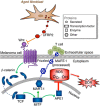In the Wnt-er of life: Wnt signalling in melanoma and ageing
- PMID: 27764844
- PMCID: PMC5129830
- DOI: 10.1038/bjc.2016.332
In the Wnt-er of life: Wnt signalling in melanoma and ageing
Abstract
Although the clinical landscape of melanoma is improving rapidly, metastatic melanoma remains a deadly disease. Age remains one of the greatest risk factors for melanoma, and patients older than 55 have a much poorer prognosis than younger individuals, even when the data are controlled for grade and stage. The reasons for this disparity have not been fully uncovered, but there is some recent evidence that Wnt signalling may have a role. Wnt signalling is known to have roles both in cancer progression as well as in organismal ageing. In melanoma, the interplay of Wnt signalling pathways is complex, with different members of the Wnt family guiding different aspects of invasion and proliferation. Here, we will briefly review the current literature addressing the roles of different Wnt pathways in melanoma pathogenesis, provide an overview of Wnt signalling during ageing, and discuss the intersection between melanoma and ageing in terms of Wnt signalling.
Conflict of interest statement
The authors declare no conflict of interest.
Figures

References
-
- Akhmetshina A, Palumbo K, Dees C, Bergmann C, Venalis P, Zerr P, Horn A, Kireva T, Beyer C, Zwerina J, Schneider H, Sadowski A, Riener MO, Macdougald OA, Distler O, Schett G, Distler JH (2012) Activation of canonical Wnt signalling is required for TGF-beta-mediated fibrosis. Nat Commun 3: 735. - PMC - PubMed
-
- Berlin I, Denat L, Steunou AL, Puig I, Champeval D, Colombo S, Roberts K, Bonvin E, Bourgeois Y, Davidson I, Delmas V, Nieto L, Goding CR, Larue L (2012) Phosphorylation of BRN2 modulates its interaction with the Pax3 promoter to control melanocyte migration and proliferation. Mol Cell Biol 32: 1237–1247. - PMC - PubMed
Publication types
MeSH terms
Substances
Grants and funding
LinkOut - more resources
Full Text Sources
Other Literature Sources
Medical

